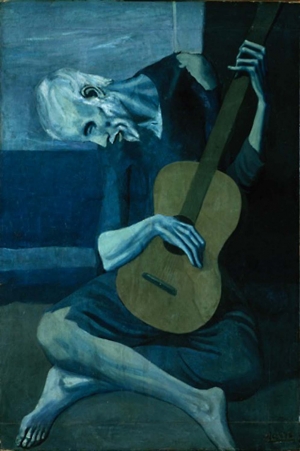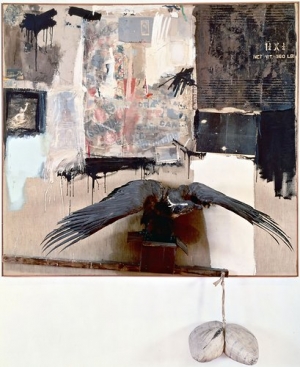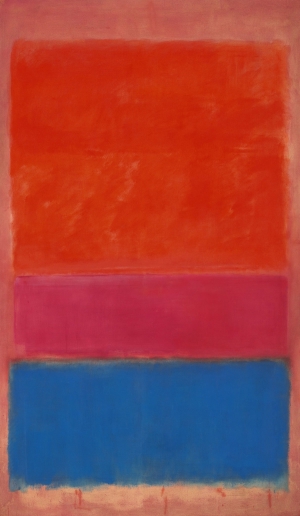|
Displaying items by tag: Modern Art

The Art Institute of Chicago is sending almost 100 European modern art masterpieces to the Kimbell Art Museum in For Worth, Texas. Part of a four-month traveling exhibition, the show at the Kimbell is slated to open on October 6, 2013 and run through February 16, 2014.
Renowned for its collection of modern European art, the Art Institute of Chicago will loan its works to the Kimbell while their own galleries undergo renovations. The Kimbell is the only museum to host the Art Institute’s traveling exhibition.
The show will include sculptures and paintings by Juan Gris (1887-1927), Georges Braque (1882-1963), Alberto Giacometti (1901-1966), Salvador Dalí (1904-1989), Paul Klee (1879-1940), Joan Miró (1893-1983), and Marc Chagall (1887-1985). Two major highlights of the show are Henri Matisse’s (1869-1954) Bathers by a River (1909-10) and Pablo Picasso’s (1881-1973) Old Guitarist (1903).
The Kimbell hosted an exhibition of Impressionist works from the Art Institute of Chicago back in 2008. The show was one of the best regarded in the Kimbell’s history.

The Centre Pompidou in Paris sent a number of French masterpieces to Shanghai’s Power Station of Art for the exhibition Electric Fields: Surrealism and Beyond – La Collection du Centre Pompidou, which opened on December 16. The show marks the first collaboration between the Pompidou, a leading museum of modern and contemporary art, and a Chinese institution.
The exhibition, which is part of the Shanghai Biennale, features approximately 100 works from the Pompidou’s collection including works by Rene Magritte (1898-1967), Andreas Gursky (b. 1955), Marcel Duchamp (1887-1968), and Ed Ruscha (b. 1937). The show is divided into six categories that explore various Surrealist themes and includes paintings, sculpture, video and manuscripts.
The show’s title is a combination of two influences – the name of the venue, a former electric power station, and Andre Breton (1896-1966) and Philippe Soupault’s (1897-1990) seminal piece of Surrealist literature, The Magnetic Fields (1919). The exhibition runs through March 15, 2013 in Shanghai.

On view through April 12, 2013 at the Cleveland Museum of Art, Picasso and the Mysteries of Life: Deconstructing La Vie is the first exhibition devoted to Pablo Picasso’s (1881-1973) complex masterpiece, which defined his well-known Blue Period. A cornerstone of the museum’s collection, La Vie (1903) is accompanied by related works on loan from Barcelona’s Museu Picasso as well as works by Francisco Goya (1746-1828), Albrecht Dürer (1471-1528), and Auguste Rodin (1840-1917) from the Cleveland Museum’s own collection.
The exhibition uses x-radiographs, infrared reflectographs, and other scientific methods to delve into the process behind La Vie. Displayed on iPads, the technological investigation illustrates Picasso’s creative process and how he altered the painting’s composition considerably before deeming the work complete.
Picasso drew preliminary sketches for La Vie in May of 1903. At the time, he was a young, unknown artist who still lived in his parents’ home in Barcelona. The first sketches depicted an artist in his studio and evolved into a more intricate scene meant to evoke thoughts about life and art and the intersection of the two. A solid analysis of La Vie has always eluded scholars due to its enigmatic subject, early history, and its relationship to Picasso’s other works from this time. However, the painting has never been examined as thoroughly and in-depth as by the Cleveland Museum of Art.
Picasso and the Mysteries of Life strives to make sense of the work by exploring the subjects of the painting. Carles Casagemas, the gaunt man featured in the work’s left foreground, was a friend of Picasso’s and a fellow artist. Casagemas committed suicide in 1901, prompting Picasso to contemplate the glorification of suicide and the bohemian lifestyle in modern art and culture. The woman standing behind Casagemas in La Vie has been identified as Germaine Pichot, his lover and a contributor to his suicide. Pichot stands as a symbol of Picasso’s coded representation of women and in a broader sense, as the fatal woman often portrayed in modern art.
A 163-page book by William H. Robinson, the Cleveland Museum’s curator of modern European art, accompanies the exhibition. The book further explores the role of La Vie in Picasso’s creative process as well as the important issues in the modernist culture of the 19th and 20th centuries that affected Picasso and his work. Robinson explores how Spanish and French literature affected Picasso’s Blue Period paintings, the impact of Rodin’s large retrospective of 1900 on the young artist, and Picasso’s ongoing struggle to fully understand the notions of fate and destiny.
Deconstructing La Vie is the inaugural exhibition in the Cleveland Museum of Art’s new Focus Gallery.

Thomas Hart Benton’s (1889-1975) epic mural, America Today (1930-31) has found a new home at New York’s Metropolitan Museum of Art. A sweeping panorama of American life, the work once lined a boardroom at the International-Style New School for Social Research on West 12th Street, which was designed by the Austrian architect, Joseph Urban (1872-1933).
The 10-panel mural, which was Benton’s first major commission, ushered in a new approach to mural painting, turning to the reality of everyday life for inspiration. America Today portrays American life prior to the Great Depression and features the flappers, farmers, steel workers, and stock market moguls that are readily associated with the period. The mural remains Benton’s best-known work and a masterpiece of modern art.
Benton, an American realist painter, drew inspiration for the mural from his travels around the United States in the 1920s. A glimpse into both rural and urban life at the time, America Today portrays the wealthy and poor as well as the progressive and traditional ideals that defined the era. While Benton did not receive a fee for the commission, the work opened the door for future commissions and helped inspire the Works Progress Administration mural programs that were implemented in the late 1930s.
Bought by the insurance company, AXA Equitable, nearly 30 years ago, America Today was in storage before the decision to donate the work was made. However, the Met is currently without extra exhibition space and the mural won’t be on view until at least 2015 when the museum takes over the Whitney Museum of American Art’s Marcel Breuer building on Madison Avenue. The Whitney is headed to its own larger space in the meatpacking district. America Today is the first artwork that Met officials have confirmed for the Breuer building.

100 years after the seminal Armory Show in New York City, The Heckscher Museum of Art presents Modernizing America: Artists of the Armory Show. On view through April 14, 2013, the exhibition features works from the museum’s permanent collection and explores the show that changed the country’s perception of modern art.
Organized by the Association of American Painters and Sculptors, the Armory Show, officially titled the International Exhibition of Modern Art, took place at the 69th Regiment Armory and introduced radical works of art to the public; a far cry from the realistic art they were accustomed to. Artists, critics, and patrons were presented with European works that boasted avant-garde sensibilities and spanned genres like Futurism, Cubism, and Fauvism. The show transformed the landscape of modern art and inspired an unmatched growth and progression in American art.
Works on view include paintings by Marguerite Zorach (1877-1968) and Arthur B. Carles (1882-1952); works on paper by Joseph Stella (1877-1946), Oscar Bluemner (1867-1938), and Charles Sheeler (1883-1965); and sculptures by artists such as Walter Kuhn (1877-1949).
The Heckscher Museum of Art was founded in 1920 by August Heckscher in Huntington, New York. The museum boasts over 2,000 works and focuses mainly on American landscape paintings as well as American and European modernism and photography.

The anxiously awaited event, Art Basel, begins tonight, December 5, with a VIP preview and runs through Sunday, December 9. Now in its 11th year, Art Basel has become a defining event in the art world and each year the city of Miami is taken over by collectors, curators, artists, celebrities, and art enthusiasts as well as a host of art fairs.
Taking place at the Miami Beach Convention Center, Art Basel features over 260 big-name galleries from around the world and exhibits works by more than 2,000 artists of the 20th and 21st centuries. Renowned for its support of young and emerging artists and galleries, Art Basel includes performance art, public art projects, lectures, and video art installations. Some exhibitor highlights include Acquavella Galleries, Mary Boone Gallery, Gagosian Gallery, Hauser & Wirth, Lisson Gallery, and White Cube, among many others.
Regarded as Miami art week’s anchor fair, Art Miami got a head start on Art Basel and hosted a VIP preview on December 4 at the Art Miami Pavilion in the city’s Wynwood Arts District. The fair, which features modern and contemporary offerings from more than 125 international galleries, runs from December 5 through December 9. While Art Basel tends to be spotlighted during Miami’s art week, Art Miami is the original and longest-running contemporary art fair to be held in the area with 23 years under its belt. Exhibitors include Douglas Dawson Gallery, Eli Klein Fine Art, Haunch of Venison, Hollis Taggart Gallery, Jerald Melberg Gallery, Michael Goedhuis, and Waterhouse & Dodd.
This year, Art Miami coincides with the inaugural CONTEXT art fair, which features 50 galleries representing emerging and mid-career artists. Located in an ultramodern pavilion adjacent to Art Miami, CONTEXT boasts indoor and outdoor projects as well as solo artist installations, curated projects, and multimedia exhibits. Between Art Miami and CONTEXT, there will be over 200,000 square feet of exhibition space and over 250 participating galleries.
Another highlight of the city’s art week is Scope Miami, which opened on December 4 with a VIP preview and will run through December 9 at a new location in the midtown arts district. With a 100,000 square foot pavilion, Scope features 20 new galleries as part of its “Breeder Program” and 85 established exhibitors. Besides modern and contemporary art, there will be design, music, and fashion offerings.
Pulse Miami opens to the public on December 6 and runs through December 9 at The Ice Palace Studios. One of Art Basel’s many satellite fairs, Pulse is in its eighth year and features 86 international galleries exhibiting works on paper, paintings, sculptures, performances, installations, and video art. Pulse also includes its signature series, Pulse Projects, a selection of installations proposed by galleries and not-for-profit institutions. This year’s Pulse Projects includes a short film by Zackary Drucker shown earlier this year at MoMA PS1, marble installations courtesy of Venske & Spanle and Margaret Thatcher Projects, and a special screening of street artist Invader’s Art 4 Space, courtesy of Jonathan LeVine Gallery.
While there are countless fairs, events, parties, concerts, and openings happening in Miami this week, one not to be missed affair is the Masterpieces from the Berardo Collection exhibit at the Gary Nader Art Centre. Opening on December 5, the show features pieces from one of the finest modern and contemporary art collections in existence. Hand-picked from the private holdings of Joe Berardo, a Portuguese mogul, the 110 works are worth $500 million. Featured artists include Francis Bacon, Jean-Michel Basquiat, Alexander Calder, Salvador Dali, Marcel Duchamp, Max Ernst, Roy Lichtenstein, Pablo Picasso, Diego Rivera, Cy Twombly, Andy Warhol, and many more.

One of the most significant artists of the 20th century, Henri Matisse (1869–1954) is best known for his use of color and fluid, innovative forms. A leading figure in modern art, the French artist defined the Fauvist movement, but defied classification. The works of Nicolas Poussin, Édouard Manet, Auguste Rodin, Paul Gauguin, Paul Cézanne, and Jean-Baptiste-Siméon Chardin inspired Matisse and he communed with groundbreaking artists such as Camille Pissarro, André Derain, and Gertrude Stein.
The Metropolitan Museum of Art’s exhibition Matisse: In Search of Painting opens on December 4 and explores the evolution of Matisse as a painter. Matisse worked rigorously, often painting the same scene and subject over and over again to gauge his own progress and compare various techniques, a process he developed during his academic training.
In Search of Painting features just 49 vibrant canvases but spans Matisse’s entire career. Organized by Rebecca Rabinow, a curator of modern and contemporary art, the exhibition places the works in pairs and groups by subject to illustrate Matisse’s methodical process. In the 1930s, Matisse began having photographs taken at various stages of each painting to document their evolution. Three of the finished canvases along with their accompanying photographs will also be on view. The juxtaposition illustrates Matisse’s own self-awareness and the arduous process that led to each finished canvas.
Matisse: In Search of Painting will be on view through March 17, 2013.

Designed by Renzo Piano, the museum that houses the collection of John de Menil and Dominique de Menil opened to the public 25 years ago. A sold-out gala is being held tonight, November 29, to celebrate. The fete has raised $2.2 million, exceeding its $1.5 million goal. This is only the third gala held by the Menil Collection as the institution already boasts an endowment of approximately $200 million thanks to support from the board, donors, and corporate sponsors.
The theme of the night will be “Celebration in Blue,” a tribute to Yves Klein, an important figure in post-war European art and a personal friend of the Menils. Among the 700 guests will be Pablo Picasso’s grandson, Bernard Ruiz-Picasso, philanthropist Agnes Gund, president emerita of the Museum of Modern Art, and hedge fund chief John D. Arnold.
A silent auction will also be held at the gala. The 31 lots include works by Ed Ruscha, Olafur Eliasson, and Richard Serra. Proceeds will support operations and exhibitions. The museum plans to expand their contemporary art collection and hope to build the Menil Drawing Institute to house and exhibit modern and contemporary works.
The free museum features over 15,000 paintings, sculptures, prints, drawings, photographs, and rare books from the 20th century, all of which were once part of the Menils extensive private art holdings. Included in the impressive collection are works by Paul Cezanne, Mark Rothko, Andy Warhol, Rene Magritte, Max Ernst, Henri Matisse, Pablo Picasso, and Jackson Pollack.

The children of the New York art dealer, Ileana Sonnabend, have donated Robert Rauschenberg’s mixed media assemblage, Canyon (1959), to the Museum of Modern Art in New York. While the acquisition is a welcomed addition to MoMA’s existing Rauschenberg collection, the work wasn’t always so warmly regarded.
The Sonnabend heirs received Canyon after their mother’s death in 2007 and the work was soon at the center of a battle between MoMA and the Metropolitan Museum of Art, where the piece had been displayed intermittently since 2005. MoMA ramped up its efforts and promised to add Ms. Sonnabend’s name to the Founders Wall in the museum’s lobby. Officials also vowed to mount an entire show devoted to Canyon as well as Sonnabend, an important player in the modern art movement. While the Met made offers of their own, the Sonnabend family ultimately decided that MoMA was the right home for the work considering the expansive Rauschenberg collection already in the institution’s possession.
Sadly, this is not the first dramatic episode Canyon has been involved in. When the Sonnabend children inherited the work five years ago, appraisers valued the assemblage at $0. The presence of a stuffed bald eagle, a bird that is protected by federal laws, halted any possible sales of trades involving the work. The I.R.S., on the other hand, shrugged this off and claimed that Canyon was worth $65 million and demanded that Sonnabend’s family pay $29.2 million in taxes and another $11.7 million in penalties.
Eventually, a settlement was worked out and I.R.S. dropped all tax charges. In order for this to happen, the Sonnabends were required to donate Canyon to a museum where it could be put on public display. Canyon will be on view at MoMA beginning today, November 28.

The Contemporary art auction that took place at Sotheby’s Tuesday night made up for any disappointment stemming from last week’s Impressionist and modern art sale. Profits from the Contemporary sale reached $375.1, the highest total for any auction in Sotheby’s history. The previous record of $362 million was set in May of 2008.
The biggest sale of the night, Mark Rothko’s No. 1 (Royal Red and Blue) (1954) stirred up some competition and ended up selling to a telephone bidder for $75.1 million after the auction house’s fees. Other impressive sales included Jackson Pollack’s Number 4, 1951 that brought $40.4 million with fees, a record for the artist, and Francis Bacon’s Untitled (Pope) (1954) that sold for $29.7 million with fees. A number of high-quality works on paper by Andy Warhol also sold well. Green Disaster (Green Disaster Twice) (1963) sold to newsprint tycoon, Peter Brant, for $15.2 million and Suicide sold to the Manhattan art dealer, Philippe Ségalot, for $16.3 million, a record for a Warhol work on paper.
Out of 69 works offered at the auction, only 11 went unsold.
|
|
|
|
|